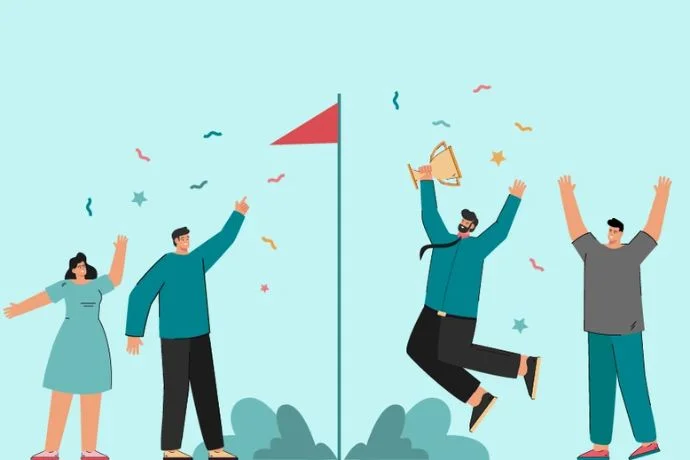How I Use Rewards to Stay Motivated in My Fitness Journey
Let’s talk about the tough part of getting fit. It’s not the first day you go to the gym and feel like anything is possible. It’s not even the day you break your own record and feel like you’re on top of the world. The dreary, boring part is the hardest. It’s Tuesday morning, six weeks into your habit, and it’s raining outside. You didn’t sleep well, and the prospect of putting on your running shoes feels like a huge task. These are the times when the fight for consistency is won or lost.
For a long time, I thought that the only way to get through these times was with pure willpower. I thought I had to “just do it” and get through every workout by sheer willpower. I thought of my fitness path as a long, hard march with the main reward being the vague aim of “being fit.” This way of doing things, as you can assume, caused a lot of people to get burned out. For a while, I would remain diligent, but ultimately, my willpower would run out, and I would fall off the wagon.
When I discovered I was disregarding a basic part of human psychology, everything changed: humans are wired to move toward pleasure and away from suffering. I was making my workouts all pain and no pleasure by treating them like a strict task. The answer? I started to plan and add rewards to my fitness journey on purpose. I’m not talking about the “eat a whole pizza after one salad” kind of thinking. I’m talking about a clever, long-lasting system of fitness incentives that encourages good conduct and makes the whole thing more fun.
It changed everything when I learned how to treat myself appropriately. It changed my workouts from something I had to do into something I wanted to do. This created a positive feedback loop that made sticking to my routine feel less like a struggle and more like a decision I was delighted to make. If you want to stay motivated for a long time, let me show you exactly how I utilize fitness rewards to do so.
The Psychology of Rewards: Why This Isn’t Just About ‘Treating Yourself’
Before we get into the “what,” we need to know the “why.” A good reward system doesn’t mean tempting yourself to work out like a kid. It’s about messing with the way your brain makes habits. A simple neurological loop makes up our brains: Cue -> Routine -> Reward.
- Cue: The trigger that starts the behavior (e.g., your alarm goes off for a morning run).
- Routine: The behavior itself (the workout).
- Reward: The positive outcome that tells your brain, “Hey, that was good! Let’s remember to do that again.”
The huge, long-term benefits of fitness, like losing weight, having more energy, or being healthier, are great, but they take time to happen. Your brain wants instant satisfaction, especially when you’re trying to form a new habit. A clever fitness rewards system gives you instant positive feedback, which makes the link between the workout and a good sensation stronger. This process moves the behavior from the prefrontal cortex, where you make conscious, effortful judgments, to the basal ganglia, where automatic habits exist.
To sum up, rewards help you keep the habit. But the most important thing is to pick the appropriate kinds of rewards—ones that honor your progress without getting in the way of it. That’s where a lot of people go wrong, and that’s where I had to learn some crucial things.

The Two Tiers of My Fitness Rewards System
There isn’t just one large prize at the end of my system. It’s a multi-layered strategy that honors both the small things that happen every day and the big things that happen. I divide my prizes into two primary groups. Process Rewards and Milestone Rewards.
Tier 1: Process Rewards – Celebrating the Daily Grind
Rewards for the process are all about recognizing the work, not the result. They happen regularly, are small, and are often right away. They are meant to make it feel nice to show up today. This is what makes fitness consistent. If you just reward yourself for huge wins, you’ll have long, discouraging times when you feel like your hard work isn’t paying off.
I learned that these small rewards had to be two things:
- Immediate: They need to happen on the same day as the workout to create a strong mental link.
- Aligned: They should support my overall health and wellness goals, not undermine them.
Here are the process rewards that have become the bedrock of my motivation system:
1. The Intrinsic Reward: Focusing on the Post-Workout Feeling
This is the most powerful and sustainable reward of all, but it requires conscious effort to cultivate. After every single workout, I have a ritual. I take 60 seconds to do a mental check-in. I stop, take a few deep breaths, and notice the feeling.
I ask myself:
- How does my body feel? (Usually energized, warm, and capable).
- What’s my mental state? (Usually clearer, calmer, and less stressed).
- What is my emotional state? (Usually proud and accomplished).
By consciously acknowledging this “post-workout high,” I’m training my brain to link exercise with nice feelings immediately. The feeling itself is the best reward for me, not an outside one. A lot of the time, I write in my workout journal, “I felt sluggish before, but now I feel sharp and full of energy.” This log is a fantastic thing to reflect back on when I don’t feel like doing anything. Reading my own words about the immediate return is frequently enough to get me going.

2. The Sensory Reward: Upgrading the Experience
This strategy is about making the workout process itself more enjoyable. Instead of viewing the workout as a bitter pill to be swallowed, I started looking for ways to make it a more pleasant sensory experience.
- The Curated Playlist/Podcast: I have specific, high-energy playlists that I only allow myself to listen to while working out. If I want to hear those songs, I have to earn them by exercising. I also use “temptation bundling,” where I’ll save the next episode of a gripping podcast exclusively for my long run or cardio session. The workout becomes the vehicle for my entertainment.
- The Post-Workout “Spa” Experience: My post-workout shower is not just a shower; it’s a ritual. I invested in a nice shower gel with a scent I love (like eucalyptus or mint). The act of washing off the sweat and feeling refreshed became a mini-reward I looked forward to. A foam roller or massage gun session while watching TV in the evening also falls into this category—it feels indulgent, but it’s actually aiding my recovery.
- The Delicious and Healthy Refuel: I have a go-to protein smoothie recipe that tastes like a milkshake but is packed with nutrients. It feels like a treat, but it’s perfectly aligned with my fitness goals. Knowing that this delicious smoothie is waiting for me is often a motivator to push through the last few reps.
3. The “Productivity” Reward: Earning Your Downtime
For a long time, I felt guilty about taking time for myself to relax. I reframed this by using my workout to “earn” my guilt-free leisure time.
It’s easy for me to follow my rule: I get a certain amount of guilt-free time off when I finish my planned workout. It could be 30 minutes to read a book, an hour to play a video game, or time to watch an episode of a show I like. I can relax and enjoy my free time because I’ve already done the “hard” and useful job for the day, so I don’t feel like I “should” be doing something else. The workout is just a way for me to buy some time to rest.

Tier 2: Milestone Rewards – Celebrating Meaningful Progress
While process rewards are for the daily effort, milestone rewards are for the tangible achievements. These are larger, less frequent rewards tied to achieving specific, predetermined goals. They provide something to strive for and mark significant progress on your journey.
The key to effective milestone rewards is setting them up in advance. You must clearly define the goal and the associated reward before you begin. This creates a clear target to work toward.
Here’s how I structure my milestone rewards:
1. Setting SMART Milestones
A vague goal like “get stronger” can’t be rewarded. The milestones must be SMART:
- Specific: “Hold a plank for 3 minutes,” not “get a stronger core.”
- Measurable: “Run a 5k without stopping,” not “become a better runner.”
- Achievable: Challenging but realistic.
- Relevant: The milestone should genuinely matter to you.
- Time-bound: “I will achieve this in 8 weeks.”
I have a hierarchy of milestones: Small, Medium, and Large.
2. Small Milestone Rewards (e.g., Monthly Goals)
These are for short-term goals, typically achieved within 2-4 weeks. The rewards are modest but desirable.
- Goal Example: Work out 15 times this month.
- Goal Example: Successfully follow my nutrition plan for 20 out of 30 days.
- Reward Ideas:
- A new book: Something I’ve been wanting to read.
- A movie night: Renting a new release and getting really good popcorn.
- A high-quality coffee or tea: I love buying a bag of beans from a local roaster.
- A fitness magazine or a new workout app subscription.
These rewards are small pleasures that add a little extra motivation to stay consistent through the month.
3. Medium Milestone Rewards (e.g., Quarterly Goals)
These are for more significant achievements that might take 2-3 months to accomplish. The rewards are a bigger investment in my hobby or well-being.
- Goal Example: Add 20 pounds to my squat.
- Goal Example: Run my fastest 10k time.
- Goal Example: Hit a 90-day streak of working out (with no more than one day off in a row).
- Reward Ideas:
- New Workout Gear: This is a classic for a reason! A new pair of high-quality running shoes, a new set of workout clothes from a brand I admire, or a new piece of equipment like a heavier kettlebell. This reward is great because it reinvests in the habit itself.
- A Massage or Spa Treatment: This is my personal favorite. It feels incredibly luxurious, but it’s also fantastic for muscle recovery. It frames self-care as a well-earned prize.
- Tickets to a Sporting Event or Concert.
- A day off work dedicated to a hobby.
4. Large Milestone Rewards (e.g., Annual or Major Goals)
These are reserved for the “mountaintop” goals, the ones that take many months or even a year of dedicated effort. The reward should be significant and something you will really look forward to.
- Goal Example: Lose 50 pounds and keep it off for 2 months.
- Goal Example: Complete a half-marathon or a Tough Mudder.
- Goal Example: Reach a year of consistent training.
- Reward Ideas:
- A Weekend Getaway: A trip to a place I’ve been wanting to visit. This is a huge motivator and provides a lot of time to reflect on the accomplishment.
- A Major Purchase: A new tech gadget I’ve had my eye on, like a high-end smartwatch or noise-canceling headphones.
- A Professional Photoshoot: A great way to celebrate a physical transformation and capture your confidence and hard work.

The Rules of Rewarding: What I Learned Not to Do
My journey with fitness rewards involved some trial and error. I learned that there are a few critical rules to making the system work without backfiring.
Rule #1: Never Use Food as a Primary Reward.
This was my worst error at first. I’d “reward” myself with a cheat meal after a week of solid workouts. This would turn into a cheat day, which would destroy my nutrition plans and make me feel lethargic and terrible. People thought of exercise as a punishment they had to do to receive junk food. Desserts are a part of a healthy diet for me now, but I never connect them to working out. I reward myself with things or experiences that aren’t food.
Rule #2: The Reward Must Match the Effort.
You can’t reward yourself with a weekend trip for going to the gym twice. The size of the award should match the size of the success. If the prizes are too easy to attain, they don’t signify anything and don’t motivate people.
Rule #3: Be Specific and Write It Down.
Don’t just have a general concept of what you want. Put it in writing and make it a promise to yourself. “WHEN I reach [specific goal], THEN I will get [specific reward].” Put it up where you can see it. This makes the aim and the reward real and tangible.
You aren’t weak if you have a smart way to reward yourself for working out; it just means you know how your mind works. It’s about being the coach you need, rewarding your hard work, and making the trip as joyful as the objective. Rewarding the process and celebrating your victories will help you stay motivated during tough times and keep your fitness fire blazing for years to come.
Frequently Asked Questions (FAQ)
Q1: Isn’t it better to be intrinsically motivated rather than relying on external rewards?
Yes, in a perfect world. The ultimate goal is intrinsic motivation, which means doing something just for the fun of it. But when you’re trying to create a new, hard habit, intrinsic drive is typically low or not there at all. Rewards from outside act as a bridge. They provide you with the first push you need to get through the first few weeks of forming a new habit. The idea is that you may give yourself time to enjoy the inherent advantages of exercise, like more energy and confidence, by employing outside rewards to keep on track. In the end, those feelings can become the main reason for doing something.
Q2: What if I set a goal and don’t achieve it? Do I still get the reward?
No, and this is really important for the system to work. Rewarding yourself anyway teaches your brain that you don’t really need to work hard. This makes the whole procedure less valuable. If you don’t reach a goal, take it as a chance to learn. Was the objective too high? Was there a mistake in your plan? Take a step back, set a new, more realistic goal, and try again. It’s important to be honest with yourself.
Q3: I’m on a tight budget. What are some free or low-cost fitness reward ideas?
This is a great question, as rewards absolutely do not need to be expensive! Some of my favorite low-cost rewards include:
- Time-based rewards: An hour of guilt-free time to dedicate to reading, a hobby, or even a nap.
- Experience-based rewards: A relaxing bath with Epsom salts, a solo hike at a local park, or an afternoon spent exploring a new neighborhood.
- Social rewards: A coffee date with a friend you haven’t seen in a while.
- Digital rewards: Creating a new workout playlist or downloading a new e-book from the library.
Q4: How do I stop a reward from becoming a “slippery slope”? For example, buying one new workout shirt turns into a huge shopping spree.
When you set the incentive, it all comes down to making sure there are clear limits. “I’ll buy some new clothes” is too vague. Instead, say “I will buy one pair of leggings from [Brand].” You make it plain when to stop by clearly outlining the reward ahead of time. Think of it like a deal. You are following the rules of the contract, not giving yourself free rein to do whatever you want.
Q5: Can social recognition be a reward?
Of course! A lot of people find that discussing their progress is a great way to stay motivated. Telling a partner or acquaintance that you reached your objective might be as easy as that. It could also mean sharing your success with a supportive online fitness group or on social media. Getting positive feedback and encouragement can be a very strong incentive that keeps you committed.





